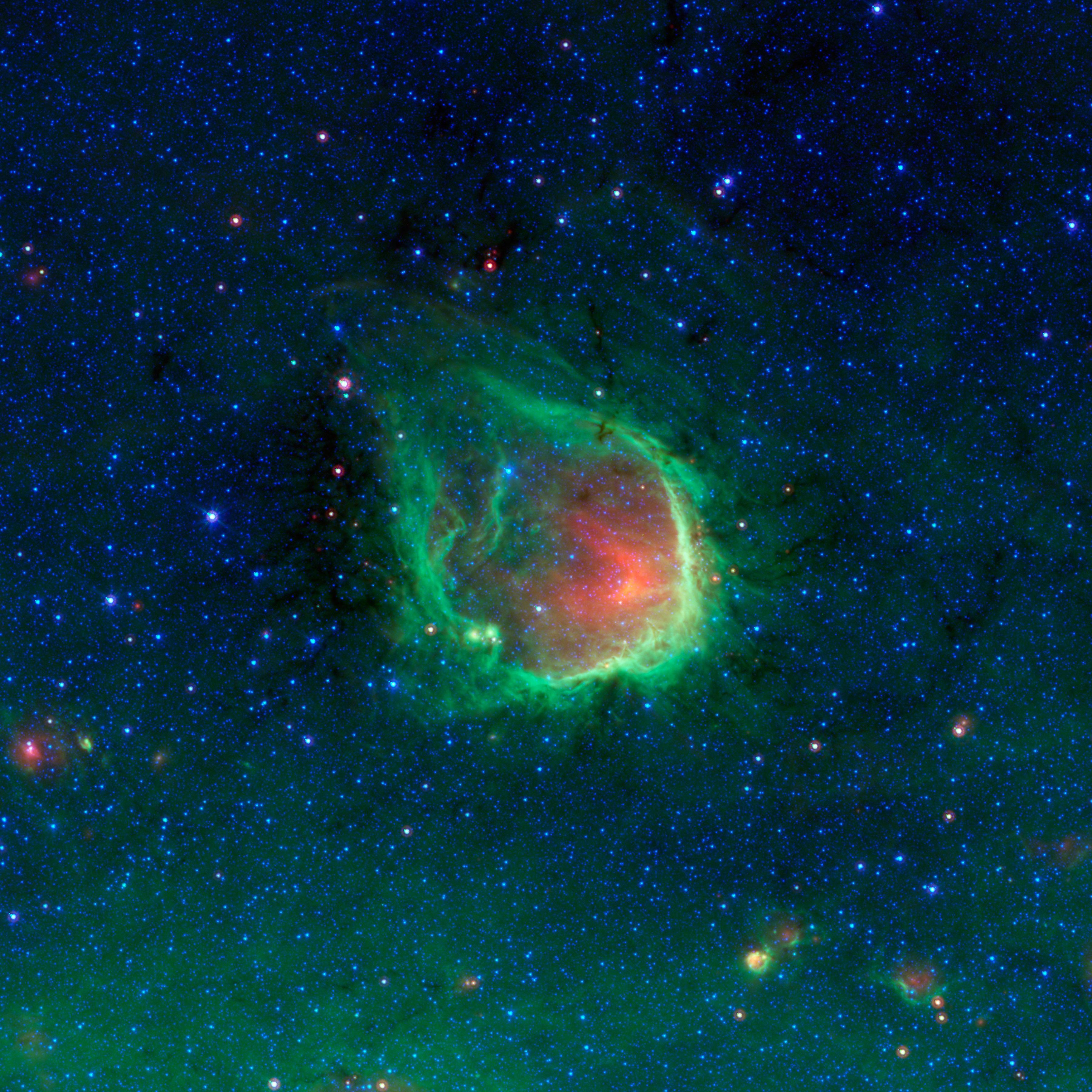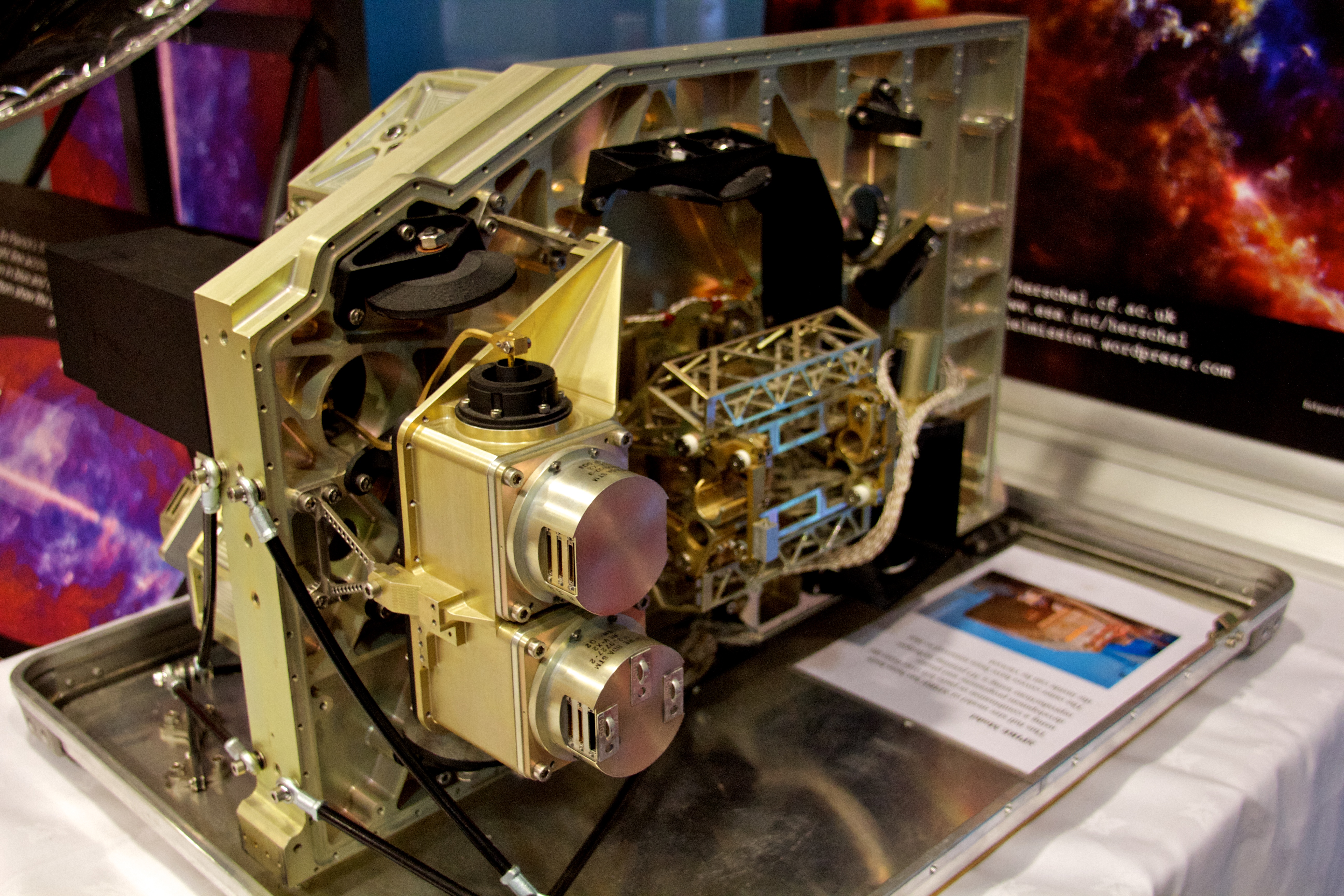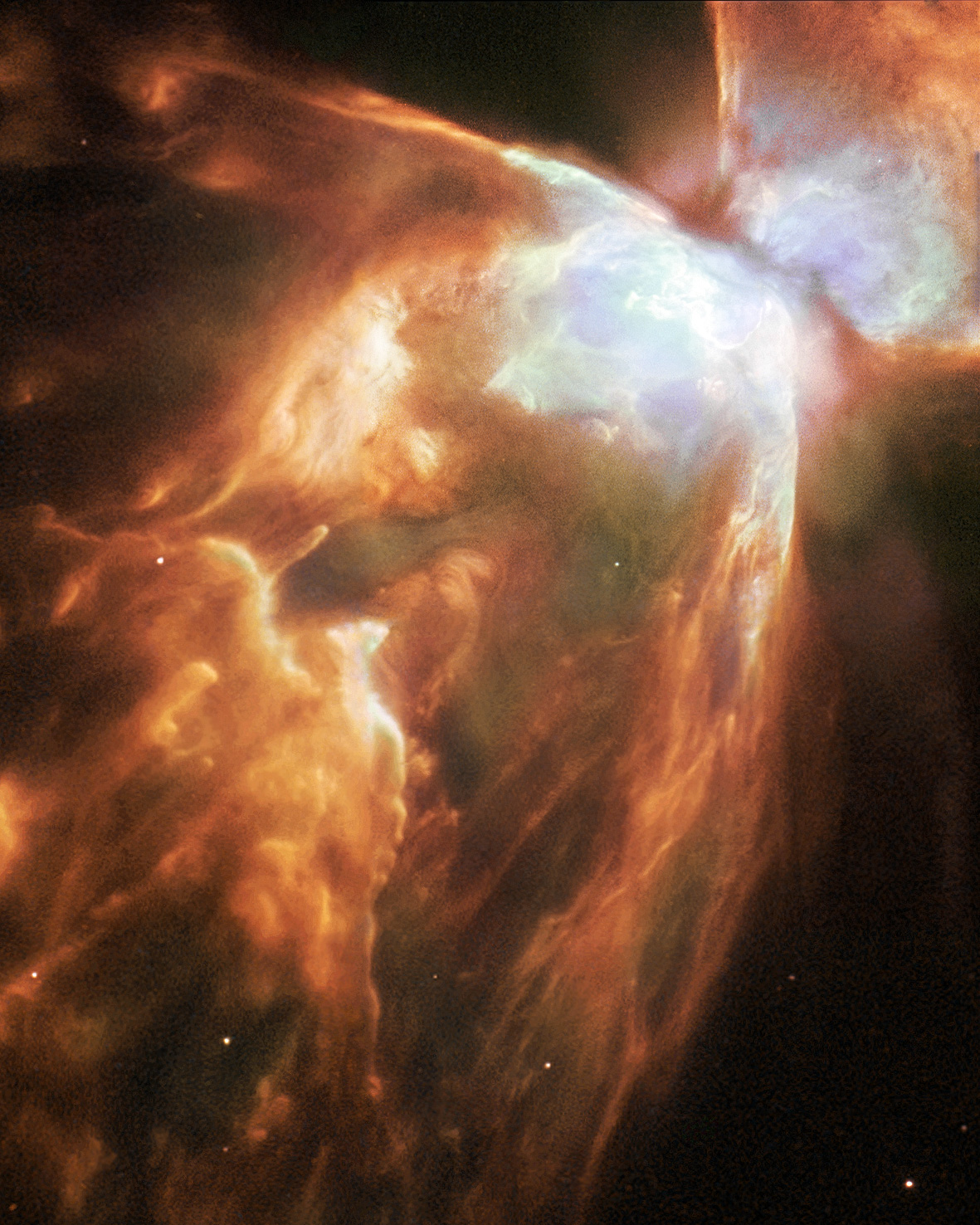|
RCW 120
RCW 120 is an emission nebula and H II region in the southern Milky Way and located some 4,300 light-years from Earth. Its designation appears in the RCW Catalogue published in 1960, whose circular diameter size is 6 arcmin. It also catalogued as Sh 2-3 and Gum 58. Veta S. Avedisova considers RCW 120 is being ionised by the O8 V star CD -38 11636 and the B2 V star VDBH 84B, and places the nebula in the star formation region SFR 348.26+0.47 along with 3 Astrophysical maser An astrophysical maser is a naturally occurring source of stimulated spectral line emission, typically in the microwave portion of the electromagnetic spectrum. This emission may arise in molecular clouds, comets, planetary atmospheres, stellar at ... CH87 347.386+0.266. The Herschel infra-red telescope's image shows an embryonic star that is likely to become one of the brightest stars in our Galaxy at some time within the next few hundred thousand years. The star now appears about ten times more massive t ... [...More Info...] [...Related Items...] OR: [Wikipedia] [Google] [Baidu] |
RCW 120
RCW 120 is an emission nebula and H II region in the southern Milky Way and located some 4,300 light-years from Earth. Its designation appears in the RCW Catalogue published in 1960, whose circular diameter size is 6 arcmin. It also catalogued as Sh 2-3 and Gum 58. Veta S. Avedisova considers RCW 120 is being ionised by the O8 V star CD -38 11636 and the B2 V star VDBH 84B, and places the nebula in the star formation region SFR 348.26+0.47 along with 3 Astrophysical maser An astrophysical maser is a naturally occurring source of stimulated spectral line emission, typically in the microwave portion of the electromagnetic spectrum. This emission may arise in molecular clouds, comets, planetary atmospheres, stellar at ... CH87 347.386+0.266. The Herschel infra-red telescope's image shows an embryonic star that is likely to become one of the brightest stars in our Galaxy at some time within the next few hundred thousand years. The star now appears about ten times more massive t ... [...More Info...] [...Related Items...] OR: [Wikipedia] [Google] [Baidu] |
Astrophysical Maser
An astrophysical maser is a naturally occurring source of stimulated spectral line emission, typically in the microwave portion of the electromagnetic spectrum. This emission may arise in molecular clouds, comets, planetary atmospheres, stellar atmospheres, or various other conditions in interstellar space. Background Discrete transition energy Like a laser, the emission from a maser is stimulated (or ''seeded'') and monochromatic, having the frequency corresponding to the energy difference between two quantum-mechanical energy levels of the species in the gain medium which have been pumped into a non-thermal population distribution. However, naturally occurring masers lack the resonant cavity engineered for terrestrial laboratory masers. The emission from an astrophysical maser is due to a single pass through the gain medium and therefore generally lacks the spatial coherence and mode purity expected from a laboratory maser. Nomenclature Due to the differences between en ... [...More Info...] [...Related Items...] OR: [Wikipedia] [Google] [Baidu] |
Sharpless Objects
Sharpless is a surname. Notable people with the surname include: * Bevan Sharpless, solar system astronomer *Karl Barry Sharpless, American chemist and Nobel prize winner *Josh Sharpless, baseball player * Christopher Sharpless, 1988 Winter Olympics bobsledder * Mattie R. Sharpless (born 1942), American diplomat *Stewart Sharpless, galactic astronomer ** Sharpless catalog, a 20th-century astronomical catalog with 313 items *Isaac Sharpless, educator *Norman Sharpless, American oncologist and director of the National Cancer Institute *Disappearance of Toni Sharpless, an American nurse who disappeared in 2009 Fictional characters *A character in Madama Butterfly See also *Sharpless asymmetric dihydroxylation, a chemical reaction *Sharpless epoxidation The Sharpless epoxidation reaction is an enantioselective chemical reaction to prepare 2,3-epoxyalcohols from primary and secondary allylic alcohols. The oxidizing agent is ''tert''-butyl hydroperoxide. The method relies on a cata ... [...More Info...] [...Related Items...] OR: [Wikipedia] [Google] [Baidu] |
H II Regions
H, or h, is the eighth letter in the Latin alphabet, used in the modern English alphabet, the alphabets of other western European languages and others worldwide. Its name in English is ''aitch'' (pronounced , plural ''aitches''), or regionally ''haitch'' ."H" ''Oxford English Dictionary,'' 2nd edition (1989); ''Merriam-Webster's Third New International Dictionary of the English Language, Unabridged'' (1993); "aitch" or "haitch", op. cit. History The original Semitic letter Heth most likely represented the voiceless pharyngeal fricative (). The form of the letter probably stood for a fence or posts. The Greek alphabet, Greek Eta (letter), Eta 'Η' in archaic Greek alphabets#Eta and /h/, archaic Greek alphabets, before coming to represent a long vowel, , still represented a similar sound, the voiceless glottal fricative . In this context, the letter eta is also known as Heta to underline this fact. Thus, in the Old Italic alphabets, the letter Heta of the Euboean alphabet ... [...More Info...] [...Related Items...] OR: [Wikipedia] [Google] [Baidu] |
Emission Nebulae
An emission nebula is a nebula formed of ionized gases that emit light of various wavelengths. The most common source of ionization is high-energy ultraviolet photons emitted from a nearby hot star. Among the several different types of emission nebulae are H II regions, in which star formation is taking place and young, massive stars are the source of the ionizing photons; and planetary nebulae, in which a dying star has thrown off its outer layers, with the exposed hot core then ionizing them. General information Usually, a young star will ionize part of the same cloud from which it was born, although only massive, hot stars can release sufficient energy to ionize a significant part of a cloud. In many emission nebulae, an entire cluster of young stars is contributing energy. Stars that are cooler than around 25,000K don't give off enough ultraviolet radiation with wavelengths shorter than 91.2nm (the wavelength needed in order to ionize Hydrogen atoms). This results in the re ... [...More Info...] [...Related Items...] OR: [Wikipedia] [Google] [Baidu] |
Cerro Tololo Inter-American Observatory
The Cerro Tololo Inter-American Observatory (CTIO) is an astronomical observatory located on Cerro Tololo in the Coquimbo Region of northern Chile, with additional facilities located on Cerro Pachón about to the southeast. It is approximately east of La Serena, where support facilities are located. The site was identified by a team of scientists from Chile and the United States in 1959, and it was selected in 1962. Construction began in 1963 and regular astronomical observations commenced in 1965. Construction of large buildings on Cerro Tololo ended with the completion of the Víctor Blanco Telescope in 1974, but smaller facilities have been built since then. Cerro Pachón is still under development, with two large telescopes (Gemini South and SOAR) inaugurated since 2000, and one in the early stages of construction (the Vera C. Rubin Observatory) The principal telescopes at CTIO are the 4 m Víctor M. Blanco Telescope, named after Puerto Rican astronomer Víctor Manuel ... [...More Info...] [...Related Items...] OR: [Wikipedia] [Google] [Baidu] |
Accretion (astrophysics)
In astrophysics, accretion is the accumulation of particles into a massive object by gravitationally attracting more matter, typically gaseous matter, in an accretion disk. Most astronomical objects, such as galaxies, stars, and planets, are formed by accretion processes. Overview The accretion model that Earth and the other terrestrial planets formed from meteoric material was proposed in 1944 by Otto Schmidt, followed by the ''protoplanet theory'' of William McCrea (1960) and finally the ''capture theory'' of Michael Woolfson. For details of Kant's position, see In 1978, Andrew Prentice resurrected the initial Laplacian ideas about planet formation and developed the ''modern Laplacian theory''. None of these models proved completely successful, and many of the proposed theories were descriptive. The 1944 accretion model by Otto Schmidt was further developed in a quantitative way in 1969 by Viktor Safronov. He calculated, in detail, the different stages of terrestrial plane ... [...More Info...] [...Related Items...] OR: [Wikipedia] [Google] [Baidu] |
Herschel Space Observatory
The Herschel Space Observatory was a space observatory built and operated by the European Space Agency (ESA). It was active from 2009 to 2013, and was the largest infrared telescope ever launched until the launch of the James Webb Space Telescope in 2021. Herschel carries a mirror and instruments sensitive to the far infrared and submillimetre wavebands (55–672 µm). Herschel was the fourth and final cornerstone mission in the Horizon 2000 programme, following ''SOHO''/'' Cluster II'', ''XMM-Newton'' and ''Rosetta''. The observatory was carried into orbit by an Ariane 5 in May 2009, reaching the second Lagrangian point (L2) of the Earth–Sun system, from Earth, about two months later. Herschel is named after Sir William Herschel, the discoverer of the infrared spectrum and planet Uranus, and his sister and collaborator Caroline Herschel. The observatory was capable of seeing the coldest and dustiest objects in space; for example, cool cocoons where stars form and ... [...More Info...] [...Related Items...] OR: [Wikipedia] [Google] [Baidu] |
Gum Catalog
The Gum catalog is an astronomical catalog of 84 emission nebulae in the southern sky. It was made by the Australian astronomer Colin Stanley Gum (1924-1960) at Mount Stromlo Observatory using wide field photography. Gum published his findings in 1955 in a study entitled ''A study of diffuse southern H-alpha nebulae'' which presented a catalog of 84 nebulae or nebular complexes. Similar catalogs include the Sharpless catalog and the RCW catalog, and many of the Gum objects are repeated in these other catalogs. However, the RCW and Gum catalogs were mainly of the southern hemisphere (Mount Stromlo is in the southern hemisphere) The Gum Nebula is named for Gum, who discovered it as Gum 12; it is an emission nebula that can be found in the southern constellation A constellation is an area on the celestial sphere in which a group of visible stars forms Asterism (astronomy), a perceived pattern or outline, typically representing an animal, mythological subject, or inanimate obj ... [...More Info...] [...Related Items...] OR: [Wikipedia] [Google] [Baidu] |
J2000
In astronomy, an epoch or reference epoch is a instant, moment in time used as a reference point for some time-varying astronomical quantity. It is useful for the celestial coordinates or orbital elements of a Astronomical object, celestial body, as they are subject to Perturbation (astronomy), perturbations and vary with time. These time-varying astronomical quantities might include, for example, the mean longitude or mean anomaly of a body, the node of its orbit relative to a reference plane, the direction of the apogee or Perihelion and aphelion, aphelion of its orbit, or the size of the major axis of its orbit. The main use of astronomical quantities specified in this way is to calculate other relevant parameters of motion, in order to predict future positions and velocities. The applied tools of the disciplines of celestial mechanics or its subfield orbital mechanics (for predicting orbital paths and positions for bodies in motion under the gravitational effects of other bodi ... [...More Info...] [...Related Items...] OR: [Wikipedia] [Google] [Baidu] |
Sharpless Catalog
The Sharpless catalog is a list of 313 H II regions (emission nebulae) intended to be comprehensive north of declination −27°. (It does include some nebulae south of that declination as well.) The first edition was published in 1953 with 142 objects (Sh1), and the second and final version was published by US astronomer Stewart Sharpless in 1959 with 312 objects. Sharpless also includes some planetary nebulae and supernova remnants, in addition to H II regions. In 1953 Stewart Sharpless joined the staff of the United States Naval Observatory Flagstaff Station, where he surveyed and cataloged H II regions of the Milky Way using the images from the Palomar Sky Survey. From this work Sharpless published his catalog of H II regions in two editions: the first in 1953, with 142 nebula; and the second and final edition in 1959, with 312 nebulae.Stewart SharplessA Catalogue of H II Regions ''Astrophysical Journal'' Supplement, vol. 4, p.257, 1959 Sharpless coordinates ... [...More Info...] [...Related Items...] OR: [Wikipedia] [Google] [Baidu] |
Monthly Notices Of The Royal Astronomical Society
''Monthly Notices of the Royal Astronomical Society'' (MNRAS) is a peer-reviewed scientific journal covering research in astronomy and astrophysics. It has been in continuous existence since 1827 and publishes letters and papers reporting original research in relevant fields. Despite the name, the journal is no longer monthly, nor does it carry the notices of the Royal Astronomical Society. History The first issue of MNRAS was published on 9 February 1827 as ''Monthly Notices of the Astronomical Society of London'' and it has been in continuous publication ever since. It took its current name from the second volume, after the Astronomical Society of London became the Royal Astronomical Society (RAS). Until 1960 it carried the monthly notices of the RAS, at which time these were transferred to the newly established ''Quarterly Journal of the Royal Astronomical Society'' (1960–1996) and then to its successor journal ''Astronomy & Geophysics'' (since 1997). Until 1965, MNRAS ... [...More Info...] [...Related Items...] OR: [Wikipedia] [Google] [Baidu] |






